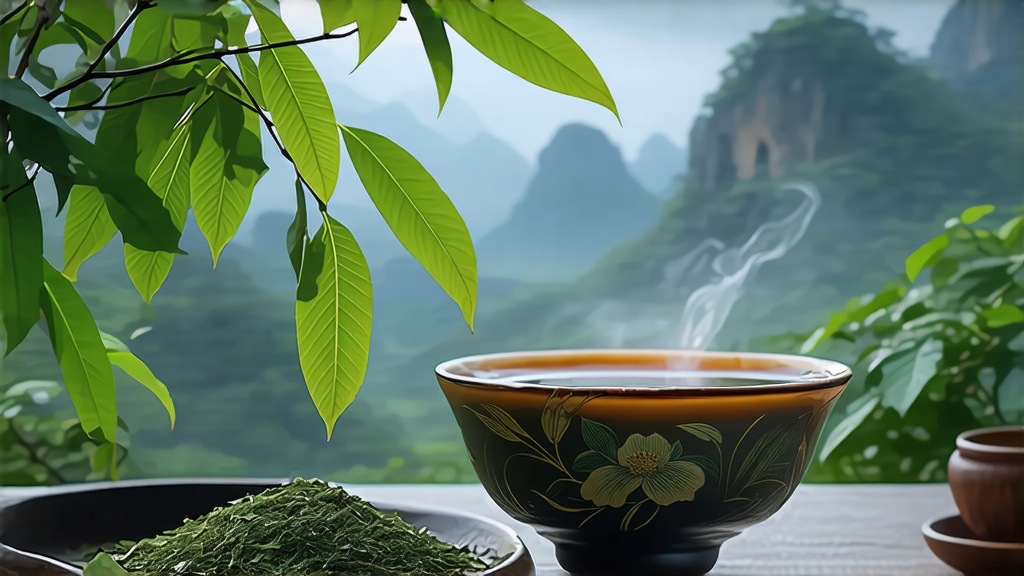
Few names in the vast lexicon of Chinese tea carry the mystique of Tie Guan Yin, “Iron Goddess of Mercy.” To the people of Anxi County in southern Fujian she is not merely a cultivar but a patron saint rendered in leaf and aroma, a daily poem recited in every village from Longmen to Xiping. Legends disagree on the century—some say 1723, others 1736—but all versions converge on a poor farmer named Wei Yin who, guided by a dream of Guanyin herself, discovered a stunted tea shrub wedged between two granite boulders behind his ancestral temple. The next morning the iron statue of the goddess seemed to glow; Wei transplanted the shrub into his garden, and the first infusion astonished the county magistrate with its orchid fragrance and lingering “yun,” a mineral echo locals still call yan yun even though no cliff rocks are in sight. The magistrate’s memorial to the imperial court earned the tea exemption from grain tax, and a legend was taxonomized into commerce.
Tie Guan Yin is technically a style, not a single plant. Within Anxi, horticulturists recognize at least eight genetically distinct clones—Red Heart, White Heart, Green Leaf, and the now-rare “Soft Branch” among them—but the benchmark remains the original Hong Xin Wei variety whose young shoots blush crimson at the stem. Micro-climate matters as much as genetics. The best gardens sit between 600 and 800 m on iron-rich lateritic soil, cooled by the maritime monsoon yet shielded by the inland Wuyi spine. Morning fog slows photosynthesis, concentrating amino acids; afternoon sun coaxing floral volatiles. The result is a leaf that can be finished in two radically different guises: the traditionally heavily roasted “Nong Xiang” (thick fragrance) beloved by Chaozhou gourmets, and the modern “Qing Xiang” (light fragrance) that stormed Beijing cafés in the 1990s with its electric-green color and spring-garden perfume. Between these poles lies a spectrum of roasting degrees, each demanding its own choreography of fire, rest, and rebirth.
Craft begins the moment the pluckers—usually women wearing fluorescent sun sleeves—snap the top three leaves and the half-open bud, a standard called “small open face.” Baskets are rushed to the village alleyways where the real clock starts ticking. Withering is done outdoors on bamboo racks called “water screens,” the leaves stirred every twenty minutes to bruise the edges just enough to invite oxidation while the sun is still mild. By dusk the leaf is limp, its grassy bite gone, and it is carried indoors for the most critical six hours of its life: the rocking. In a waist-high drum lined with 3 mm mesh, the tea master inserts 12 kg of withered leaf, clamps the lid, and begins a mechanical seesaw—25 rpm, 3 minutes on, 2 minutes off—repeated 25 times. Each toss fractures cell walls, releasing enzymes that convert catechins into thesaflavins and thearubigins, the molecules responsible for Tie Guan Yin’s golden liquor and peach-skin mouthfeel. Between cycles the leaf is spread two fingers thick on the floor to breathe; the room smells like cut apple turning to pear then to magnolia. When the leaf’s central vein becomes translucent—an event known as “green turning red”—oxidation is arrested with a 280 °C tumble in an electric wok barely wider than a satellite dish. The kill-green lasts seven minutes, short enough to lock in floral aromatics, long enough to evaporate the grassy hexenals that would later sour. While still warm the leaf is wrapped in square cloth bundles the size of a pillow and subjected to the “cold compression” unique to Anxi: a hydraulic press exerts 1.2 tonnes for three minutes, twisting the leaf into the characteristic half-ball shape that resembles a snail shell. This step fractures more cells, allowing roasted notes to penetrate during the final bake. The cycle—press, unwrap, fluff, rest—is repeated 32 times over eight hours, a marathon that reduces 10 kg of fresh leaf to 2.2 kg of finished tea. For Nong Xiang style the pellets are then transferred to a charcoal oven where longan-wood embers hold 70 °C for 36 hours, rested one week, then rebaked at 60 °C for another 24. The wood’s sweet resin